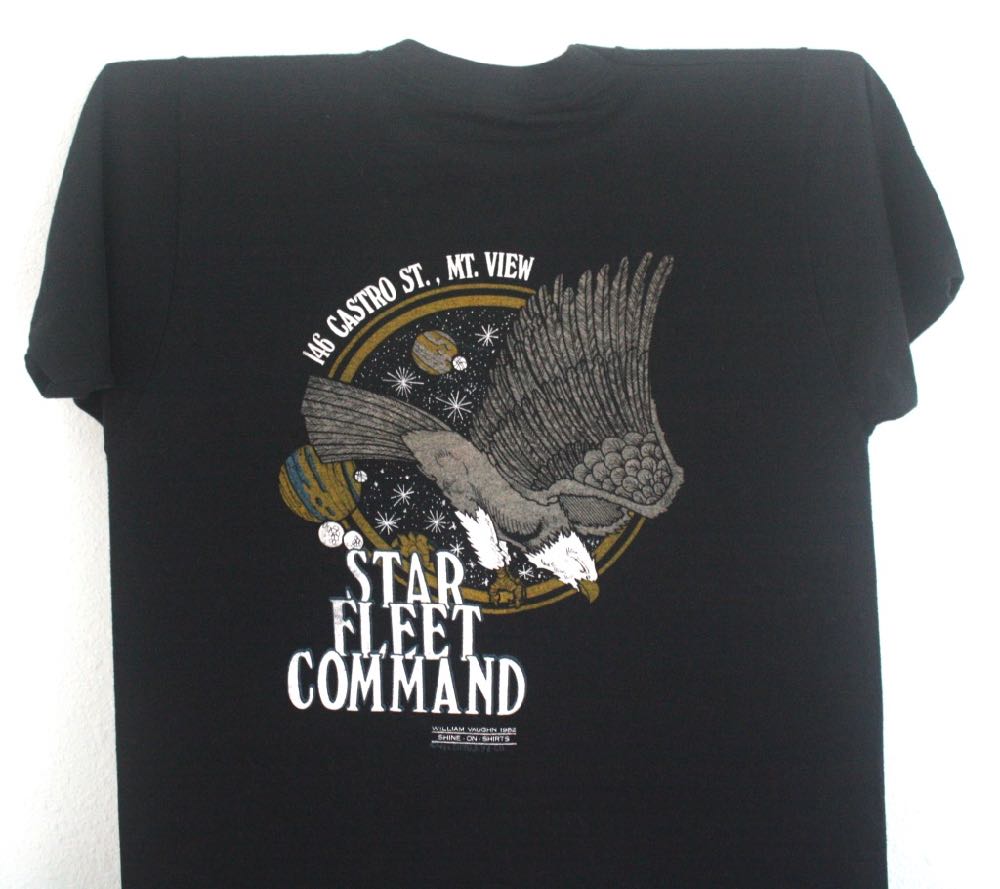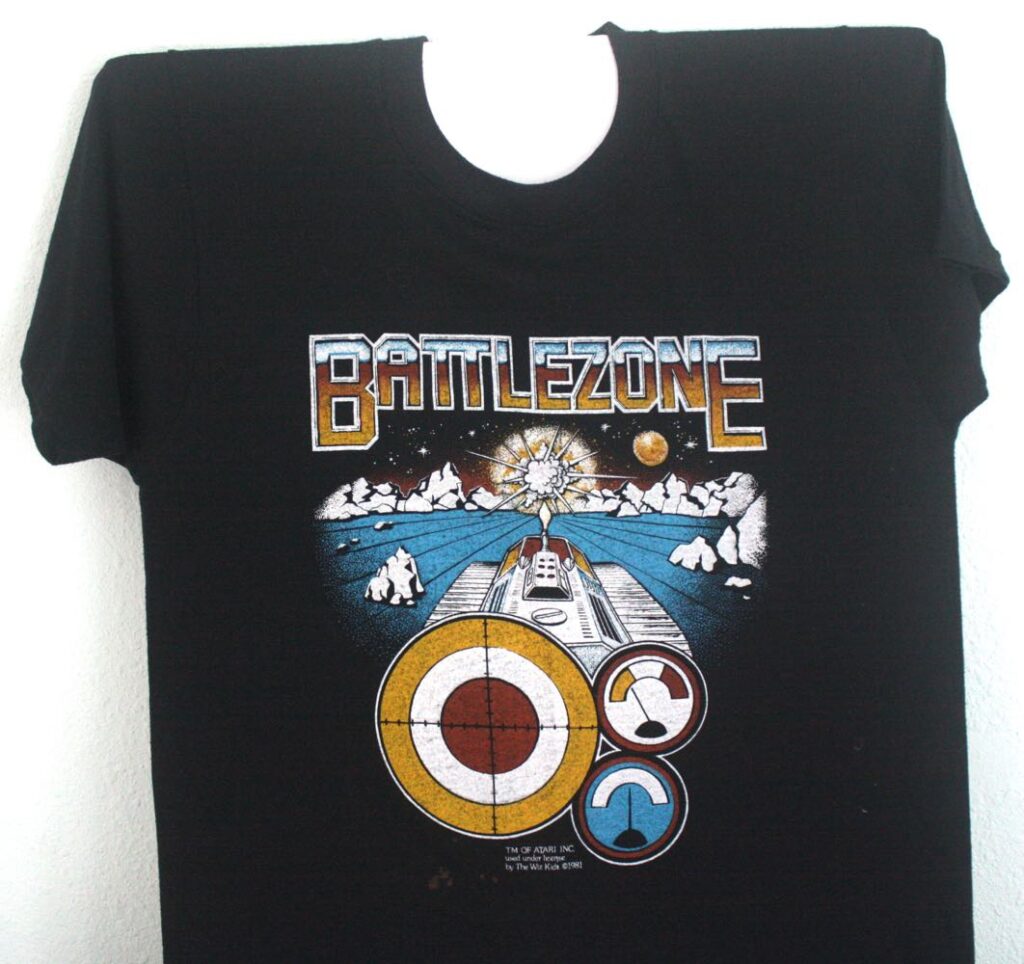T-shirts from video game arcades are almost as rare the arcades themselves. Video arcades still exist, here and there; but their glory years passed decades ago.

This “Star Fleet Command” video arcade tee hails from 1982 or so: those were the glory years. And what really makes this t-shirt special is the other side:

Battlezone, baby, a 1980 first-person-shooter tank war video arcade game rendered in faux 3-D. Everything — the landscape, the tanks, the rocks you used for cover — was a see-through wireframe vector graphic. Battlezone had a spooky, remote feel: as if you really were sealed inside an advanced tank on another planet and could only sense the threats around you through a stark 3D control interface.
Battlezone lacked cute sound effects. The rumble of the treads, the sound of weapons fire, explosions: that was it. When hit by your weapons, enemy tanks shattered into component bits that fountained gracefully across your viewscreen in slow and terrible motion.
Battlezone had something vaguely, fascinatingly horrible going for it. You rumbled forward into darkness, dodged and shot half-blindly at spectral dreadnaughts made of glowing lines. A faceless enemy would emerge from the gloom, firing. Meanwhile, more and more tanks loomed on the long range scanners. Missiles and then more missiles rushed at you from nowhere. There was no help on any side. Until….
Life can be bleak. So was Battlezone. I played it a lot. Even though I sucked at it.
Like Battlezone, this arcade t-shirt hails from a special point in space-time; Silicon Valley, 1982. The first video game golden age peaked in 1982, when video arcades ruled gaming and quarters streamed like water into the coin slots of games like Space Invaders, Pac-Man, Missile Command, Donkey Kong, Battlezone, and so many more. In 1982 America boasted 10,000 video arcades: twice the number of two years earlier.
Silicon Valley was still the heart of video gaming, and of consumer computing of all types. Video game giant Atari Inc. was in the heart of the heart. Atari, the firm that launched video games as we know them, was perhaps a ten-minute drive from Star Fleet Command. Even Battlezone was an Atari product. Atari ruled.
Nearby, other companies also worked on games and game systems. Still other new companies wrote early personal computer applications or even developed new personal computers, new operating systems, new peripherals. A rainbow Apple hung into the air over Cupertino.
Techies swarmed the streets at lunchtime, in brief escape from concrete tilt-ups and low-slung corporate campuses. They might line up for Chinese takeout or seek out a Togo’s sandwich shop to order a #16 (The Italian) and a Diet Pepsi.
They might even pick up their dry cleaning. Then they’d rush back to their desks to code and sweat and code. Or test, or document. The Friday night company beer bust could not come soon enough.
Still, some of them thought that they were changing the world. Perhaps they were. Some of them most certainly visited a video arcade after work to lax out in a generated universe. Perhaps even Star Fleet Command.
Greater things were to come, but this can’t be denied: video games were the first product of high-tech that most people actually interacted with. Atari’s Pong video consoles showed up in bars and bowling alleys as early as 1972, and people poked and prodded them and wondered where the flippers were. I know I did. Other coin-op video games followed quickly.
Along the way, the public learned to understand up-and-down arrows, buttons, joysticks, screen messages, menus, help screens, and so on. Call it User Interface 101. And they got a taste of the generated wonders that a computer could project onto the inside of a cathode-ray screen. Wire-frame tanks were just the prelude.
Not many years past 1982, things changed. The video game market crashed and resurrected itself in a different form: better home gaming systems, more independent gaming developers, more powerful PCs that could run graphically better games. And there were more and more PCs in American homes.
There were winners and losers in this reshuffle; Atari was not exactly a winner. The arcades survived, in reduced numbers. Coin-op consoles never again dominated video gaming, and they made a lot less money.
For whatever reason, Star Fleet Command seems to have vanished around 1987. Maybe the crash took it. Or maybe it was just time to do something else.
Arcades still exist, but they’ve changed. Some are adult-oriented, attached to eating and drinking establishments. Some feature classic game consoles from the ‘80s and a nostalgia experience (and alcohol). Some arcades are more “gaming parlors” with high-powered PCs ready to play any game that you want, by yourself or with other players on the house network.
And some arcades are still aimed at children of all ages, young and old. The amusement park in my towns has a big one. I must admit: I haven’t been there in ten years.
But if I came face to face with a Battlezone console, even now, it just might pry a few tokens out of me. And take me on another night ride to the Other Side.
